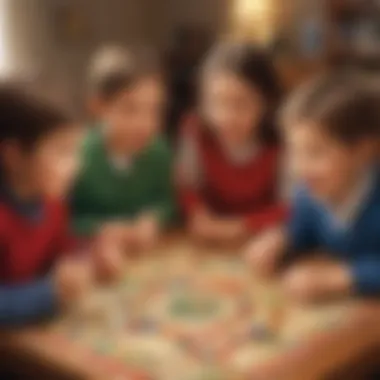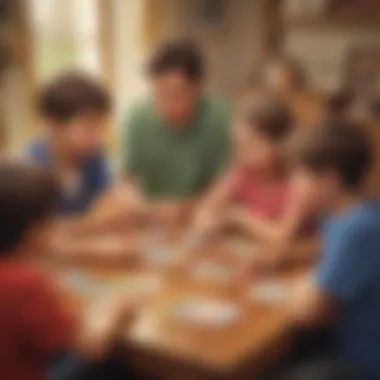Engaging Games for Teaching Time-Telling Skills


Intro
Understanding how to tell time is like having a compass in life's journey. It offers children not just the skill to know when it's lunchtime, but also helps them shape their days, meet commitments, and respect others' time. As elementary school kids embark on this essential skill, what better way to engage them than through games? By integrating play with learning, we can make the process of learning to tell time fun, memorable, and effective.
In this exploration, we delve into a variety of playful activities that cultivate time-telling skills. Parents and educators alike will find this guide invaluable for nurturing essential life abilities in a manner that's both interactive and enjoyable. Through creative crafts, amusing quizzes, and engaging articles, kids aged five to twelve will not only learn how to read a clock but also develop a keen sense of time management.
Creative Activities
When it comes to teaching kids about time, creative activities serve as an excellent avenue. Kids have the chance to learn through hands-on experiences, and they engage their minds and imaginations in the process.
Craft Ideas
Crafts can turn the abstract concept of time into something tangible. Here are a couple of engaging craft ideas that children can replicate:
- Clock Sliders: Using paper plates, markers, and brads, kids can design their own clocks. The hour hand and minute hand can be moved, giving them the chance to practice setting different times.
- Time Capsules: Let children create a personal time capsule where they jot down what they are doing at different times of the day, like breakfast at 8 am or bedtime at 8 pm.
Step-by-Step Guides
Clock Sliders
- Gather a paper plate, two small paper arrows, and a brad.
- Create an outline of a clock face with numbers using different colors.
- Attach the arrows with the brad to allow movement.
- Encourage children to practice setting various times.
Time Capsules
- Provide a small box or container.
- Have children define their daily routine with times written on paper.
- Seal the time capsule and revisit it after a week to evaluate what’s changed.
Educational Value
Engaging in these activities not only solidifies time-telling skills but also enhances creativity, fine motor skills, and critical thinking. The hands-on approach maintains children's interest and makes it easier for them to retain concepts related to time management.
Fun Quizzes
Additionally, integrating fun quizzes into the learning experience reinforces time-telling knowledge in a playful way. These quizzes can be a regular fixture to test and enhance their understanding.
Quiz Topics
On platforms like ElemFun, quizzes tackle various subjects, such as:
- Reading analog clocks
- Understanding digital time
- Differentiating between a.m. and p.m.
- Calculating elapsed time
Question Types
Quizzes incorporate a mix of question types to keep things lively:
- Multiple-choice questions that challenge their knowledge.
- Fill-in-the-blank formats to test their memory.
- Scenario-based questions that prompt them to contextualize what they've learned.
Knowledge Reinforcement
Regular quizzes are excellent for solidifying concepts. They prompt children to recall information, nurturing a deeper understanding of how time functions in their daily lives. Plus, this interactive method keeps their engagement levels high, making it a win-win!
Knowledge Sources
Not to forget, supplementing games and quizzes with fact-based articles provides a rich layer of context for children. Articles can break down time-related concepts into easily digestible bits, fuelling further interest.
Topics
The articles available may cover:
- Historical evolution of clocks and timekeeping.
- Different ways cultures measure time.
- How time zones affect global interactions.
Engaging Content
The presentation of such information is crucial. Articles written in accessible language, sprinkled with relatable examples, captivate the young mind. Engaging storytelling combined with informative content enhances comprehension.
Preamble to Time-Telling Skills
The ability to tell time goes far beyond just reading the numbers on a clock. It's an essential life skill that intertwines with the understanding of daily routines and effective time management. Children who grasp time-telling can synchronize their activities, understand the concept of schedules, and develop a sense of responsibility. In this article, we’ll explore how games can enhance these skills, making learning both fun and effective.
Understanding the Importance of Time Management
Time management is like having a compass that guides individuals through their daily lives. For children, learning how to manage time instills a sense of accountability and provides them with a framework for prioritizing tasks. When kids learn to tell time, they don’t just become better at reading clocks; they develop a perception of time that can lead to greater independence.


- Self-regulation: Kids learn to allocate their time wisely, whether for homework, play, or rest.
- Decision-making: Understanding time helps them make decisions about when to start or finish activities.
- Goal-setting: Children can set attainable goals and deadlines, fostering a growth mindset.
The Developmental Stages of Learning Time
Children typically progress through specific stages as they learn to tell time. Recognizing these stages can help parents and educators tailor their approaches to teaching this skill.
- Initial Understanding (Ages 4-5): At this stage, children may recognize what clocks are and understand the basic concept of time. They might relate time to daily occurrences, like lunchtime or bedtime.
- Analog Awareness (Ages 6-7): Kids start to differentiate between hours and minutes as they learn to read analog clocks. This becomes a playful endeavor as they connect the hands of the clock to real time in their environment.
- Digital Time Reading (Ages 8-9): Children begin to read digital clocks and learn about military time, gathering a more comprehensive understanding of how different formats convey time.
- Advanced Time Management (Ages 10-12): As they approach the pre-teen years, kids start using time in practical scenarios, like setting alarms or managing their schedules. This stage is crucial for fostering independence in managing daily activities.
The pathways to acquiring time-telling skills can be enriched through engaging games. Such activities not only reinforce learning through play but also make the process joyous. The vital years of ages five to twelve present opportunities to integrate time-telling games into learning environments, whether at home or in classrooms.
Types of Games for Learning Time
Using games as tools for learning time is a clever approach. Such games lighten the mood and banish boredom while teaching essential skills. They make an often abstract concept, like time, more concrete and relatable. Kids learn through play, and when they enjoy what they’re doing, it sticks better. Fostering time-telling skills through various forms of games can strengthen cognitive abilities and enhance understanding of daily routines. The result is a solid foundation not just in telling time, but in time management.
Board Games Focused on Clocks
Board games that center on clocks serve as an engaging way for children to grasp the basic concepts of time. Games like Tell Time with Tilly or Clock Around require players to recognize clock faces and set times correctly. This interaction with physical pieces makes the learning experience tactile, which is especially beneficial for younger children. The visual and physical elements of these games can help solidify the knowledge of hour and minute hands, creating a clear picture in their minds.
These games often promote social interaction, allowing children to navigate rules, take turns, and share strategies. This not only builds their math skills but also helps them develop critical soft skills such as patience and teamwork. When children see their peers engaged, it fosters a sense of excitement that isn’t easily achieved in traditional learning environments.
Digital Games and Apps
In this ever-evolving technological landscape, digital games and apps have thrust time-telling into the 21st century. Applications like Endless Numbers or Time Monsters introduce an animated experience, inviting kids to interact with time in novel ways. With colorful graphics and intricate stories, children can immerse themselves in learning while maintaining their interest.
These platforms often come equipped with adaptive learning features, adjusting the challenges to suit individual skill levels. This customization enables a child to advance at their own pace, making the learning process more encouraging. Moreover, many apps include rewarding animations that provide instant feedback, which can be highly motivating.
Importantly, digital mediums allow for access anywhere and anytime. Kids can practice at their leisure, whether during a commute or a quiet afternoon at home, making learning to tell time more flexible.
Role-Playing and Simulations
Role-playing games offer an imaginative avenue for mastering time-telling skills. By placing children in hypothetical situations where they need to ask for the time or plan events, they can grasp how time functions in daily life. Simulations like setting a dinner time or scheduling playdates provide context, which helps reinforce their learning.
For example, setting up a mock store where children have to handle transactions based on a clock can teach them to calculate how much time they have left to close up shop. This approach highlights the functional use of time, showcasing its importance in various social interactions.
Such role-playing sparks discussions about time zones, punctuality, and time-based responsibilities. Children learn that being late can affect plans, which is a crucial life lesson.
"Interactive learning through games not only teaches time but helps children manage it, enhancing their everyday lives."
Interactive Activities for Young Learners
Engaging young learners in the process of acquiring time-telling skills is essential, and interactive activities play a pivotal role. Such activities help children grasp concepts related to time in a memorable and tangible manner. The hands-on approach not only boosts comprehension but also makes the learning process enjoyable and dynamic.
Through interactive activities, children can see the clear connections between the abstract notion of time and their everyday lives. Simple tasks like crafting a clock can spark curiosity, fostering a spirit of exploration. It’s not just about telling time; it's about understanding its flow, structure, and significance. Moreover, these activities can be tailored to suit various age groups, ensuring that each child, regardless of their stage of learning, can partake meaningfully.
Crafting Your Own Clock
One fascinating interactive activity is crafting your own clock. This task enables children to engage with the concept of time directly. Kids can learn to identify hours and minutes by physically constructing a clock that they can use day by day.
- Materials Needed:
- Steps to Create the Clock:
- A cardboard circle
- A pair of scissors
- Markers or paints
- A brad fastener for the hands
- Begin by cutting out a large circle from the cardboard. This will be the face of your clock.
- Divide the clock face into 12 sections, marking the hours clearly.
- Use markers to number the hours and paint or decorate to your liking.
- Attach two clock hands (using the brad) at the center, allowing them to move freely.
Once completed, children can practice setting the time, reinforcing their understanding of time management and recognition. The crafting process also promotes fine motor skills, making it doubly beneficial.
Flashcard Games for Time Recognition
Flashcard games serve as another effective way to bolster time-telling skills. This activity can be easily customized, making it versatile to any learning environment, whether at home or in classrooms. Flashcards can display various times, helping kids connect visual symbols with the actual concept of time.
- Creating the Flashcards:
- Game Ideas:
- Use cardstock to make flashcards that show different clock faces with different times.
- On the opposite side, write the corresponding digital time, like 3:00, 10:15, etc.
- Memory Match: Place all cards face down and have children take turns flipping two at a time, trying to match the analog and digital representations.
- Speed Round: Set a timer and see how many matches they can make in one minute. This game can bring some friendly competition into the learning process.
This method not only helps with time recognition but also enhances memory and cognitive skills.
Engaging children in these activities wraps learning in excitement, making the teachings more likely to stick long-term.
Benefits of Game-Based Learning


Game-based learning has become a cornerstone in modern educational practices. It features prominently in the effort to teach time-telling skills to young learners. The term encapsulates various methods where learners engage in games designed not just for fun but tuned specifically to enhance knowledge and skills. One might think of games merely as childish fun, but herein lies a treasure trove of cognitive and engagement benefits that elevate the learning experience.
Promoting Cognitive Development
At its core, game-based learning harnesses the innate curiosity and playfulness children embody. When children engage in time-telling games, they’re not simply memorizing hour and minute divisions; they are exercising their cognitive muscles. The interaction demands them to think critically about time, make quick mental calculations, and develop spatial awareness—especially evident with physical clock models.
For instance, a child playing a board game such as "Tick Tock Bingo" needs to recognize various times on a clock while racing to fill in their boards. This process not only reinforces time recognition but also stimulates memory retention and problem-solving skills. Research shows that when children learn through play, their brains are more wired to retain that information.
Moreover, these games can pave the way for a deeper understanding. Instead of rote learning, children who engage with games that involve scenarios and challenges might learn, for example, the reasons we synchronize for events—say, why we need to respect time zones when coordinating a video call with a friend abroad.
Enhancing Engagement in Learning
Engagement is crucial for effective learning. When kids collaborate, compete, or play, they're more likely to absorb information without the weight of traditional educational pressure. Game-based learning flips the script: teachers and parents observe children learning invaluable skills—like telling time—while they're focused on having fun.
Think about the classic game of "Simon Says" but adapted to include time-telling instructions. For example, when “Simon” says, “Simon says show me 3 o’clock,” the kids jump in, simultaneously learning to associate the position of the hands on a clock with verbal instruction. This method caters to different learning styles and keeps students interested, making it easier to accommodate diverse classrooms.
Additionally, children often thrive in a collaborative environment. Group games allow them to bond over shared tasks and goals. This social aspect wielding peer interaction not only solidifies their understanding of time but also hones skills like teamwork, respect for others’ input, and patience. The fun factor in these settings lays fertile ground for more serious learning later; kids who enjoy the process will be more likely to continue seeking knowledge.
In summary, game-based learning is not merely an instructional tool; it’s a bridge fostering cognitive growth and deep-seated engagement among young learners.
By marrying play with the learning of essential life skills such as time management, we craft an educational environment where understanding flourishes. This integrated method supports various aspects of a child’s development, making the idea of learning to tell time both effective and enjoyable.
How to Choose the Right Game
Selecting a game that effectively teaches time-telling skills is no small feat. It requires understanding the unique needs of the child as well as the educational goals in mind. A game can serve as a powerful tool in a child’s learning journey, encouraging not just knowledge acquisition but also a love for learning. Here, we breakdown the essential aspects to consider for making the right choice.
Assessing Age Appropriateness
Age is more than just a number; it's a key determinant in how easily a child can grasp the concept of time. When selecting a game, one must first assess the developmental stage of the child. Games designed for older kids often come with more complex rules and may involve strategic elements that younger children may not yet be able to navigate.
Factors to think about:
- Cognitive Development: Younger kids, say around five to eight, benefit from simple games that use colorful visuals and interactive elements. Think of a game that uses bright clock graphics to help visualize hours and minutes.
- Engagement Level: Children aged nine to twelve might enjoy competitive settings or digital games. For instance, an app that has a race against the clock might align better with their interests.
- Cultural Relevance: Some games include local contexts or languages that may resonate better with certain age groups. Again, it’s about connecting the learning with what appeals to them emotionally and cognitively.
Aligning Games with Learning Objectives
Choosing the right game also revolves around ensuring it aligns with the learning objectives set for time-telling. Each child must leave the game feeling as if they've achieved something valuable. Consider these points:
- Educational Content: The game should inherently aim to teach specific skills related to time. For instance, does the game require players to analyze clock faces? Does playing advance their ability to distinguish between different times of the day?
- Skill Progression: Look for games that cater to incremental learning. A well-structured game might begin with whole hours and gradually introduce half hours, quarter hours, and ultimately minutes. This gradual increase in complexity can help foster confidence and competence.
- Feedback Mechanism: Games that provide instant feedback help players understand their mistakes. If a child misreads the time on a clock, a game that gently points out the mistake can be more effective than one that simply rewards correct answers.
Choosing a game thoughtfully not only enhances the learning experience but also fosters an environment that encourages curiosity and growth. As you navigate through selections, remember that it's not solely about play; it’s about enriching a child’s understanding of an essential life skill.
Remember: The right game can turn learning into an engaging adventure, making every tick of the clock a moment of excitement.
Creating a Structured Learning Environment
Creating a structured learning environment is essential when teaching children how to tell time. This approach fosters a sense of stability and progress, making it easier for kids to engage with the concept of time. Like a sturdy foundation for a house, a structured environment supports their learning journey. A few key elements play a role in achieving this.
First, consider the physical space. Designating a specific area for time-related activities can minimize distractions and signal to kids that it’s time to focus. Adding clocks, timers, or even themed decorations can create a time-centric atmosphere. In this area, children can see the relevance of what they are learning and how it fits into their daily lives.
Second, structure also involves organizing materials and resources. Having all necessary supplies — worksheets, games, and various tools — accessible and ready to go eliminates unnecessary frustration and helps maintain momentum. A cluttered environment can lead to confusion, while an organized one saves time and energy.
Additionally, setting routines is critical. Establishing predictable schedules for learning sessions provides children with the comfort of knowing what to expect. For example, practicing time-telling skills right after a lunch break can become a daily ritual, anchoring learning in their daily routine.
The benefits of creating a structured learning environment are manifold. Children learn best when they feel secure and supported, and a well-organized setting can improve focus, encourage independence, and instill confidence. Parents and educators play a crucial role in this process, guiding children to be proactive in their learning.
Setting Goals for Time Learning
Setting achievable goals for learning about time can significantly boost a child's motivation. Goals should be specific, measurable, attainable, relevant, and time-bound — often referred to as SMART criteria. For instance, a child might aim to distinguish between half-past and quarter-past times within a two-week timeframe. This gives them a target to work towards, making the learning process feel more purposeful.
When formulating these goals, it’s beneficial to involve the child in the conversation. Ask them what they want to achieve or what specific time-telling skills they find challenging. This sense of ownership can enhance their engagement and drive.
Incorporating Routine Practice
Routine practice is the backbone of mastering time-telling skills. It's not just about sitting down once a week with a worksheet. Instead, integration into daily life is key. Here are a few strategies:
- Daily Time Checks: Encourage children to check the clock several times a day, reinforcing their learning in real-time.
- Develop a Time-Telling Journal: Children can document their practice sessions, keeping track of what they've learned and areas needing improvement.
- Use Technology Wisely: Various apps and digital games prompt regular practice and can fit seamlessly into kids' routines.
Incorporating these regular practices into daily life transforms time-telling from a chore into a natural part of their day. By turning these moments into learning experiences, children will start to view the clock as a friend rather than an adversary.
Consistent practice helps reinforce learning, making it easier for children to grasp complex concepts in time management.


Evaluating Progress in Time-Telling Skills
Assessing how well kids can tell time is vital. Just like a gardener checks the soil to ensure plants grow strong, parents and educators need to evaluate the time-telling abilities of children. This not only highlights areas of strength but also pinpoints challenges that might need extra attention. Regular evaluations can make understanding time less daunting and more of a game.
Monitoring progress gives insights into how effective the games and activities are in enhancing learning. It’s a good idea to use various methods to gauge understanding—because, as every experienced tutor knows, a one-size-fits-all approach rarely works in education. Games are merely the first step; consistent evaluations ensure these lessons stick in kids' minds.
The Importance of Regular Evaluation
- Identifying Learning Styles: Different children absorb information in unique ways. Some might grasp time-telling better through visual aids, while others prefer hands-on experiences. Evaluations help figure out what works best.
- Boosting Confidence: Regular assessments, if done right, can celebrate successes and reduce anxiety when mistakes occur. Kids feel encouraged when they see they’re improving.
- Adapting Instruction: As children show progress or struggle, adjustments might be needed in teaching methods or game selection. The dynamic nature of kids' learning is a game in itself.
Once educators grasp where children stand with their time-telling skills, they can guide further learning with tailored strategies. Now, let’s delve into how assessments and quizzes can be effectively utilized.
Using Assessments and Quizzes
To measure how well students are learning to tell time, assessments and quizzes are key. They help gather solid data on which skills have been mastered and which ones still need polishing. Here’s how assessments can work wonders:
- Variety is Key: Keep assessments varied to cater to different learning styles. This can include written quizzes, interactive online challenges, or hands-on clock activities.
- Frequent but Low-Stakes Assessments: Frequent quizzes don’t have to be high-pressure. Instead of a final exam, consider shorter quizzes that allow kids to learn without the fear of failing. Think of it as collecting small pebbles instead of a big boulder.
- Game-Based Assessments: Some digital games come with built-in assessments. These can track a child's progress in real-time, making learning feel less like work and more like play. There are even games that include a score-tracking element, providing instant feedback.
A well-designed quiz doesn’t just measure knowledge; it can also engage children’s interest in learning more about time. However, just knowing the facts isn’t enough. Feedback is critical to help students improve further.
Feedback Techniques for Improvement
Feedback plays a crucial role in helping kids refine their time-telling skills. It’s like a compass guiding them on their learning journey. Here are some effective feedback techniques worth considering:
- Specific Praise: Instead of a simple "good job," specifics can help. For instance, saying "You did a great job identifying quarter past three!" provides a clear notion of what they excelled at.
- Encouraging Reflection: Ask kids how they think they performed and what they could do differently next time. This fosters a growth mindset, allowing them to take ownership of their learning.
- Actionable Suggestions: Provide clear next steps for improvement. Maybe suggest they practice with a particular game that focuses on the skill they struggled with during an assessment.
- Peer Feedback: Create opportunities for children to share their learning experiences with classmates. Working in groups can foster collaboration and deepen understanding. Children often feel more at ease discussing and learning with their peers.
Ultimately, feedback isn't about pointing out faults; it's a tool for growth. When children receive actionable feedback, they learn more effectively.
In summary, evaluating progress in time-telling skills requires consistent assessments and constructive feedback. Together, they help nurture confident, capable learners who can tell time with ease.
Parental Involvement in Learning
Involved parents can have a substantial impact on their children's educational journey, particularly in acquiring vital skills like time-telling. By taking an active role in their child's learning process, parents not only reinforce concepts taught in school but also foster a supportive environment. This engagement can make learning become less of a chore and more of an enjoyable experience.
Creating a Fun Learning Atmosphere at Home
Establishing a fun and welcoming atmosphere at home is crucial when it comes to teaching time-telling skills. Here are a few strategies that can help parents create that environment:
- Use Visual Aids: Clocks with vibrant colors or cartoons can capture a child's interest. They don't just see time on a clock; they see characters they like or themes they enjoy.
- Incorporate Games into Daily Life: Simple activities can go a long way, like asking kids to set the timer for different tasks, or counting down to meal times. This integrates time-telling into their daily routines.
- Make Story Time Interactive: When reading stories that mention specific times, ask questions like, "What time do you think they will arrive?" These questions stimulate their thinking and make them rethink time contexts.
Parent involvement at home helps reinforce what children learn in school, bridging gaps and ensuring comprehension. The warmth of parental support transforms essential skills into skills that kids enjoy mastering.
Guiding Children Through Games
Once a fun learning atmosphere is created, guiding children through time-related games becomes an avenue for practical learning. Here’s how parents can facilitate this process:
- Modeling Gameplay: Rather than just handing over a game, sit down with your child and show them how to play. Your involvement will encourage them and provide an example of how the game helps teach time. It’s not just about winning; it’s about learning.
- Adjusting Game Difficulty: Tailor the complexity of the games to fit your child's learning level. If they are just starting to learn, simpler games may keep their interest. As they grow more comfortable, gradually introduce more challenging aspects.
- Prompting Learning with Questions: While playing, throw in questions that make them think. For instance, if they land on a space that says, "Set the clock to 3:00," ask them, "What do you think happens at 3:00?" Questions like these reinforce learning through active participation.
By guiding through both fun and educational games, parents can turn these moments into fruitful learning experiences while keeping the process light and entertaining.
Engagement plays a vital role in learning; when parents are active participants, children feel more motivated to grasp new concepts.
Parental involvement isn’t just a bonus; it’s a key ingredient in helping children develop essential life skills, like telling time. Through a mix of fun, games, and guidance, parents can pave the way for their children’s future understanding of time.
Closure and Future Directions
In summing up the journey we’ve taken through the realm of games that enhance time-telling skills, it becomes evident that this topic serves not just as a means to teach a vital life skill, but also as a gateway to engaging children in learning. Playing games that focus on time helps children not only grasp the concepts of hours and minutes but also embrace the notion of time management. As we look to the future, it’s crucial to consider how parents, educators, and caregivers can continue nurturing these skills.
We'll dig into a few specific elements that stand out:
- Integration of Learning and Play: This article highlights the significance of blending gameplay with learning to reinforce time-telling skills. Children seem more receptive to absorbing information when it’s wrapped in a fun, engaging context.
- Diverse Learning Approaches: The types of games we covered—board games, digital applications, role-playing—allow various avenues for children to explore time concepts. This variety caters to different learning styles, making it possible for every child to find an approach that resonates with them.
- Collaboration with Parents and Educators: The involvement of adults in guiding children through these games cannot be overstated. As partners in learning, adults can provide the support and encouragement needed to solidify these skills.
Following the path set by these games, kids can develop a more profound understanding of time management, which is tremendously important for their academic success and daily lives.
Ultimately, the future lies in creating a sustained emphasis on time-telling skills through innovative methods and a community approach that involves both parents and educators. By continuously fostering an environment where game-based learning flourishes, we equip children not only to master time but also to appreciate its value in their lives.
Summary of Key Points
- The integration of games in time-telling instruction fosters a deeper understanding of time management among children.
- A mix of learning styles is accommodated through various game types, enhancing engagement.
- Parental and educator involvement is key to reinforcing skills learned through games.
Encouraging Lifelong Learning of Time Management
As we conclude this exploration of games aimed at enhancing time-telling skills, it’s crucial to recognize the importance of encouraging lifelong learning. Time management doesn’t end at mastering the clock; rather, it evolves as children grow. Teaching kids how to understand and manipulate time effectively sets them on a path for academic success and personal growth.
Promoting habits like establishing routines, prioritizing tasks based on time, and understanding the importance of deadlines can be reinforced by revisiting time games periodically. Furthermore, these games can be revisited at various life stages by adjusting their complexity to introduce new concepts related to time, such as scheduling or planning events.
In doing so, children not only become adept at telling time but also learn to manage their time efficiently, paving the way for future successes in every undertaking.







